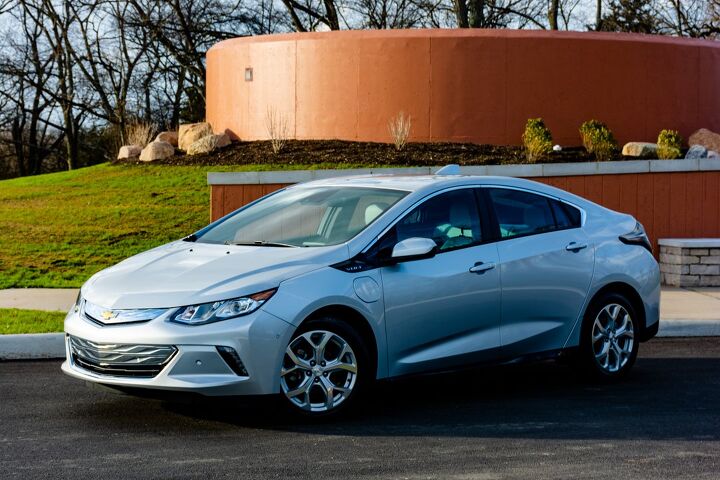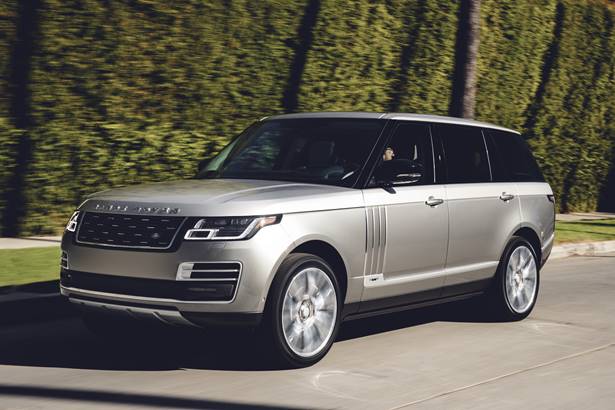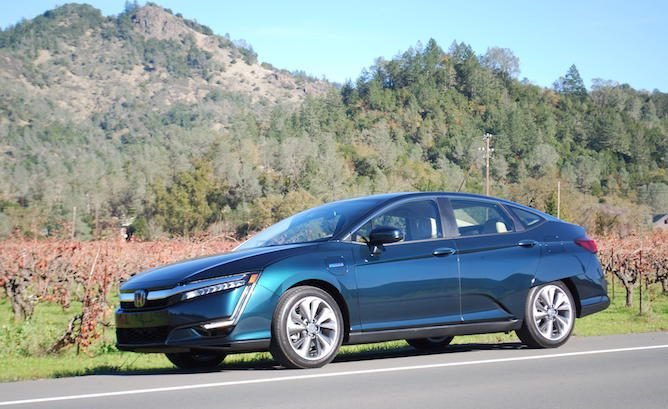#Plug-inHybrid
Jaguar Land Rover Less Certain About Battery Powered SUVs in 2019
Despite delivering what could be considered a desirable premium EV with the I-Pace, Jaguar Land Rover admits it’s not entirely sold on the idea of electric sport utility vehicles. Due to their size, SUVs and crossovers are inherently heavier than traditional sedans — placing them at odds with the goal of maximizing efficiency.
More mass means diminished range. While this can be offset by a manufacturer installing larger battery packs, that increases costs and ultimately adds more heft to the single heaviest component in an EV. Large electrics bring other issues to the engineering table, too.
“The larger the vehicle the larger the aero challenge. If you’re not careful you end up with such big batteries and you make the vehicles so heavy that as you race down the autobahn the range disappears,” Nick Rogers, JLR’s head of engineering, told media at the company’s revamped engineering and design center in Gaydon, England.
Ferrari's First Plug-in Hybrid Makes 986 Horsepower, Sometimes
On Wednesday, Ferrari introduced the SF90 Stradale — the Italian marque’s first plug-in hybrid.
The car, which represents a changing of the guard for exotics, starts with an F154 V8 engine that the company claims has been worked over to a point where it can no longer be directly compared to the exiting architecture. While the twin-turbo V8 produces 769 horsepower by itself, three electric motors lend a further 216 ponies, making for an all-wheel-drive vehicle with a grand total of 986 hp.
2019 Chevrolet Volt Review - An Elegy
Fully electric cars keep popping up, from startups and legacy automakers alike. They are likely the future. But I’m not ready for them, and likely neither are you.
Until nationwide infrastructure and car charging technologies allow for both a 300-mile range (typically the range of a kid’s bladder) and a 10-to-15 minute full recharge time, the internal combustion engine will always find a home in my driveway. I need the flexibility to drive across several states without plugging in.
That’s where a plug-in hybrid, like this 2019 Chevrolet Volt, makes all the difference. While it can run for over 50 miles without using gasoline, the gas engine charges the batteries, allowing for range similar to that of a traditional car. It’s the real-world way to go green.
V12 + Green: Plug-in Hybrids to Succeed Lamborghini's Aventador and Huracan
Lamborghini has talked a lot about electrification over the last few years, remaining careful never to commit to anything. While meager production rates seriously limit the environmental impact of its vehicles, the Italian automaker is nonetheless subject to the same pressure to go green as larger brands. Almost a decade ago, the brand vowed to reduce the carbon dioxide emissions of its vehicles by roughly one third while simultaneously covering the factory roof with solar panels. It later hinted it might implement widespread turbocharging, much like Ferrari, or go the electrification route.
The greenwashing trend continues today, likely encouraged by Lamborghini’s suddenly eco-conscious parent, Volkswagen. Facing an important crossroad, and surrounded by regulatory and environmental pressures, the company has chosen its path. While Lamborghini’s Stefano Domenicali still seems gently apprehensive, the CEO claims plug-in hybrids will be the best way forward for the brand.
Forget Diesel - Tough Times Now Lie Ahead for the European Plug-in Crowd
The European new car market is in a period of extreme flux. Once-dominant diesels are on the way out thanks to new regulations, looming bans, and cancelled tax incentives, with electrified vehicles poised to take over the high-MPG role.
But not everything’s rosy in the clean, green market on the other side of the Atlantic. A new, more accurate way of measuring fuel economy went into effect last month, and governments — as well as automakers — suddenly realized certain vehicles weren’t as clean as initially thought. Looking to buy a plug-in hybrid in the UK? Say goodbye to that juicy government incentive.
Jeep Renegade Plug-in Promises to Conquer Nature the Socially Acceptable Way
There’s a raft of changes coming to Jeep’s Renegade for the 2019 model year, but the brand’s run-down of the various alterations for the U.S. market didn’t include the possibility of a gas-electric variant. That’s what’s coming to the model, however, as Fiat Chrysler looks to ditch its overseas diesel powerplants by 2021 and curry favor with green governments (and buyers).
On Monday, Jeep announced it had begun preparations for the production of a plug-in hybrid variant of its smallest model.
2019 Range Rover Offers Up a Shiny British Bauble for Environmentalists
Whenever I see a Range Rover — the true Range Rover — I always assume there’s someone connected to the music industry behind the wheel. Just like Lambos and hockey players, we associate a type of person with a type of vehicle. And, given its origin as a vehicle designed to crush vegetation beneath its wheels while coddling its occupants with the supple hide of dead livestock, “environmentalist” is not the persona we associate with Land Rover’s Range Rover stable.
We’ll have to change our assumptions. For 2019, Range Rover’s glitziest nameplate adds a plug-in hybrid variant, allowing drivers to spew zero tailpipe emissions while taming nature in classic Victorian fashion.
2018 Volvo XC60 T8 E-AWD Review - Silent Serenity
One of the downsides of doing this job is adapting to a new car every week. While the joy of never actually performing maintenance on your daily driver makes up for it, I struggle with basic tasks at times that should be second nature. Various cars have different locations for parking brakes, for example — I once stomped toward what I thought was a pedal-actuated parking brake, and instead caught my toe on the hood release.
That struggle extends to plug-in hybrids like this 2018 Volvo XC60 T8 — I simply forget to plug the darned thing in. Volvo quotes up to 17 miles of all-electric range. My commute to the office is right around 8 miles. I rather like the idea of not using a drop of gasoline to get to the day job, but two things conspired to keep me from that goal: my general idiocy, and the intoxicating torque supplied by this innovative powertrain.
Electric Lincoln: 2020 Corsair PHEV Appears in Arizona
Lincoln continues to ramp up its SUV and crossover offerings, mirroring the mother ship that recently announced it’s ditching anything with four doors and a trunk.
Spy photogs have captured what certainly appears to be the Lincoln Corsair PHEV while testing in northern Arizona. The giveaway that this Lincoln can be plugged into the mains? A suspicious looking flap, located in the traditional FoMoCo location for recharging: just ahead of the driver’s door.
Piston Slap: Go Blue, Wither the Long Range Cruiser?
Hi Sajeev:
With the demise of diesel cars and 21 gallon fuel tanks, I am on the hunt for a true long-range cruiser. The “old” diesel cars were big, comfortable and had a freeway range of over 800 miles. Not that I would actually drive 800+ miles in one sitting.
But, with highway construction and traffic delays being what they are nowadays, an 800 mile range boils down to a usable 500 or 600 miles or so of real range-free worries. And yes, I have been known to do a single day 1,000+ mile trip. So, a sedan or coupe (van maybe?), comfortable on a long trip, and reasonably reliable. I do a lot of overnight driving.
And, no “add a fuel tank.” Lets keep it stock. Suggestions?
Polestar 1 Performance Hybrid Finishes Winter Testing, Heads Southeast for Chinese Debut
Polestar is building the cars Volvo can’t rationalize for its core demographic — high-powered electrics not intended for the general populace. While the brand has tweaked its Swedish autos in the past, Geely’s acquisition of Volvo Cars has seen Polestar evolve into a standalone division with its own unique performance lineup. But its stables are currently empty, at least until Polestar 1 enters into production.
In the interim, the Volvo subsidiary will continue showing the 600-horsepower coupe off to whet the appetites of the global market. That includes the United States because, as of last month, you can preorder one for yourself for $2,500. But production won’t begin in China until next year, and Geely doesn’t want that factory to go to waste. So Polestar will likely trickle out information and multimedia relating to its first model for the entirety of 2018.
This week, we were treated to a video of it attacking a snowy rut during some extreme winter testing inside Sweden’s portion of the Arctic Circle. Interestingly, the car in the video is camouflaged. But we’ve already seen the 2-door sports hybrid uncovered at the Geneva Motor Show — and it just us, or does the Polestar 1 look a little bit like Lincoln persevered with the LS and eventually spawned a coupe variant?
Kia Telluride May Be Headed for Production
You’ll recall the Kia Borrego, a body-on-frame SUV introduced by the Korean manufacturer at the colossally wrong moment. Fuel prices skyrocketed, the economy tanked, and the Borrego was shuffled off to the glue factory after a single model year. Hardly the machine’s fault, then.
In 2016, Kia showed off the Telluride concept, a full-sized SUV with a lantern jaw. With American buying habits consistently trending in that direction, it may be an opportune moment for Kia to re-enter the segment. According to Aussie site motoring.com.au, that time may be now.
Charge It, Jeeves: Bentley to Unveil Bentayga Plug-In Hybrid
Making good on a statement made a year ago, Bentley will show a plug-in hybrid variant of its cross-eyed uniquely styled Bentayga at March’s Geneva Motor Show. This continues its expansion of a model that is already built with a 6.0-liter W12 and, in some markets, a 4.0-litre diesel V8. A gasoline-fuelled V8 is apparently on tap, too.
This will mark the first electrified vehicle for the luxury brand, one better known for bespoke interiors than batteries and kilowatts. Going forward, though, there’s an increasingly excellent chance that electrons will spread like wild kudzu across the model range.
2018 Honda Clarity Plug-In Hybrid First Drive - Star Captain Joins the Team
(In keeping with our goal of providing interesting and varied content, we sometimes bring you stories published by TTAC’s sister sites that we feel will satisfy your discerning tastes. This first drive review of Honda’s Clarity plug-in hybrid comes to us from a familiar name. It was first published by Hybrid Cars.)
Honda has rolled out its newest salvo in the effort to wean drivers off gasoline.
In a three-pronged approach, a team simultaneously deploys multiple solutions to solve a particular problem. We see this tactic at work when your humble author tries to assemble furniture or harried parents attempt to get their toddler to eat dinner.
Rather than placing all their eggs in one particular alternative-fuel basket, Honda has decided to pursue a cadre of options: a plug-in hybrid, a battery-powered all-electric, and a hydrogen fuel cell car. So confident are they in their gambit, the company has developed a car that can be equipped with either of these three powertrains.
The machine you see here is the Honda Clarity.
2017 Toyota Prius Prime Advanced Review - All Charged Up
Like it or not, bias is always going to be a concern whenever consuming any sort of media. Efforts can be made to present fair and balanced reporting on any issue, but the problem is, quite simply, that news organizations are made up of people who hold their own opinions. The best way the reader/listener/viewer can navigate the bias is to know what those biases are, and account for them.
Let me be clear – I’m biased against the Prius. Nearly two decades of negative reinforcement about the Prius and Prius drivers have hardened a dislike of the little wedge that promises nothing but slow driving in the left lane. Minimal performance and a focus on fuel economy above nearly all else is foreign to those of us who truly enjoy driving.
Thus, I dreaded the arrival of this 2017 Toyota Prius Prime to my driveway, worrying that I might doze off from sheer boredom during my commute. When I saw the white paint applied to the vehicle’s sharply-angled flanks, I was further concerned about the appliance-like nature of this plug-in people hauler.





























Recent Comments